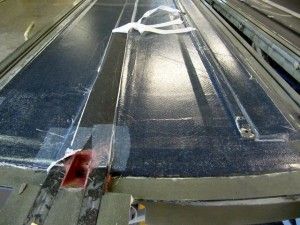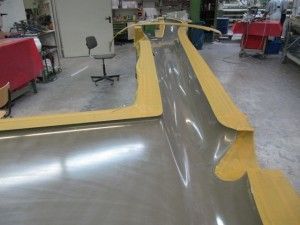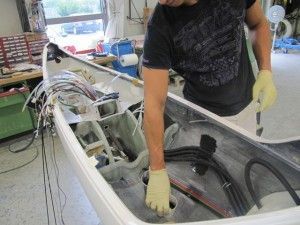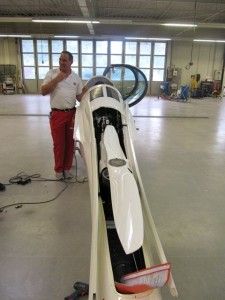During a recent vacation in Europe, my wife Charlotte and I decided to contact the folks who run the DG/LS sailplane factory in Bruchsal, Germany, and arrange a tour.
Actually, we made arrangements well before leaving the U.S. and planned our excursion to Bruchsal in between stays in Berlin and Salzburg, Austria.
As an LS-8 owner and pilot, I was keen to see how the current generation of LS and DG sailplanes metamorphose from rolls of carbon and fiberglass cloth and pails of resin into the beautiful creations that we glider pilots fawn over and trust our lives to.

DG-1000 wing skin and spar in mold
The factory is located in an industrial park on 1 Otto Lilienthal Way. The entire facility is housed in a very large modern rectangular building that was built 10 years ago after the current owner, Friedel Weber, decided to move it from its old location on the other side of the city.
The exterior and interior are very modern, the offices and workspaces are spacious and well-appointed with large windows (in the offices) and plenty of extra room. A cheery, sunny atmosphere prevails. It is truly a 21st Century sailplane factory, unlike most of its European competitors, which occupy much older facilities.
The huge work areas are arranged logically, smoothly proceeding from the room where fuselages, wings, and small parts are built, to the initial assembly room where the wing and fuselage halves are mated, thence to the finishing and polishing area, and the final assembly room.
Our tour was arranged by Managing Director Holger Back, who assigned Jelmer Wassenaar, a young engineer and pilot, to guide us through the factory. Jelmer is a world class racing pilot, having competed in two WGCs.
Our first stop was by DG-1000 wing molds, where fuselage halves were in various stages of production, The molds are heated to 40C by running hot water through them during the layup, then to 60C for final curing. One of the last DG-800 fuselages was also in the molds.
Jelmer pointed out a space in the first work room that has been reserved for building windmill propellers. This is an example of another market that DG is entering to supplement its primary sailplane business.

DG-1000 fuselage mold
In the initial assembly room, workmen were filling and sanding fuselage seams in DG-1000s and DG-800s, and applying a mixture of cotton flock and resin to the canopy rim groove to improve the fit. Each canopy has to be custom fitted to its glider by this largely trial and error process.
In the finishing room we saw a young worker painstakingly wet sanding an LS-8 (or LS-10?) horizontal stab.
The final assembly room appears to be the largest room in the factory. We saw an LS-10 in for repair and maintenance (it must be nice to simply drive your ship to the factory for repairs!), and a host of other sailplanes in various stages of readiness.
A new LS-10 (with engine) and LS-8a were almost ready to go, pending final detailing and instrument installation. There were also two DG-1001Ms on the floor.

Plumbing a DG-808 cockpit
The 1001M is the new self-launch variant of the DG-1000, which has a more powerful engine compared to that of its predecessor, the DG-500MB. This engine includes electronic ignition and electronic fuel injection, as well as some minor changes. To start the engine in DG self-launchers, once the pre-start checklist is completed, the pilot simply flips one switch. The engine bay doors open, the prop deploys, and the engine starts. According to Jelmer, the entire process takes only 5-6 seconds.
The DG-1001M is already shipping. By the time this article is published, No. 3 should be in the U.S.
At the end of our tour, we stopped by Stefan Dörnemann’s office to chat a bit. Stefan is a factory inspector and is the LS customer representative. I had met Stefan on the exhibit floor at the 2010 SSA convention in Little Rock, Arkansas.

DG-1001M prototype fuselage in the finishing room
While waiting for our taxi to the hotel, we were treated to coffee and refreshments in the conference room by the lobby. Thanks to Rita Rodrigues-Windisch for the delicious treats and for arranging the taxi and to Maria Pfund for the coffee. Thanks also to Holger and Jelmer for the fascinating tour and especially to Jelmer for taking two hours out of his work day to guide us through the factory and for patiently answering our many questions.











1 comment for “Visit to the DG/LS Factory”